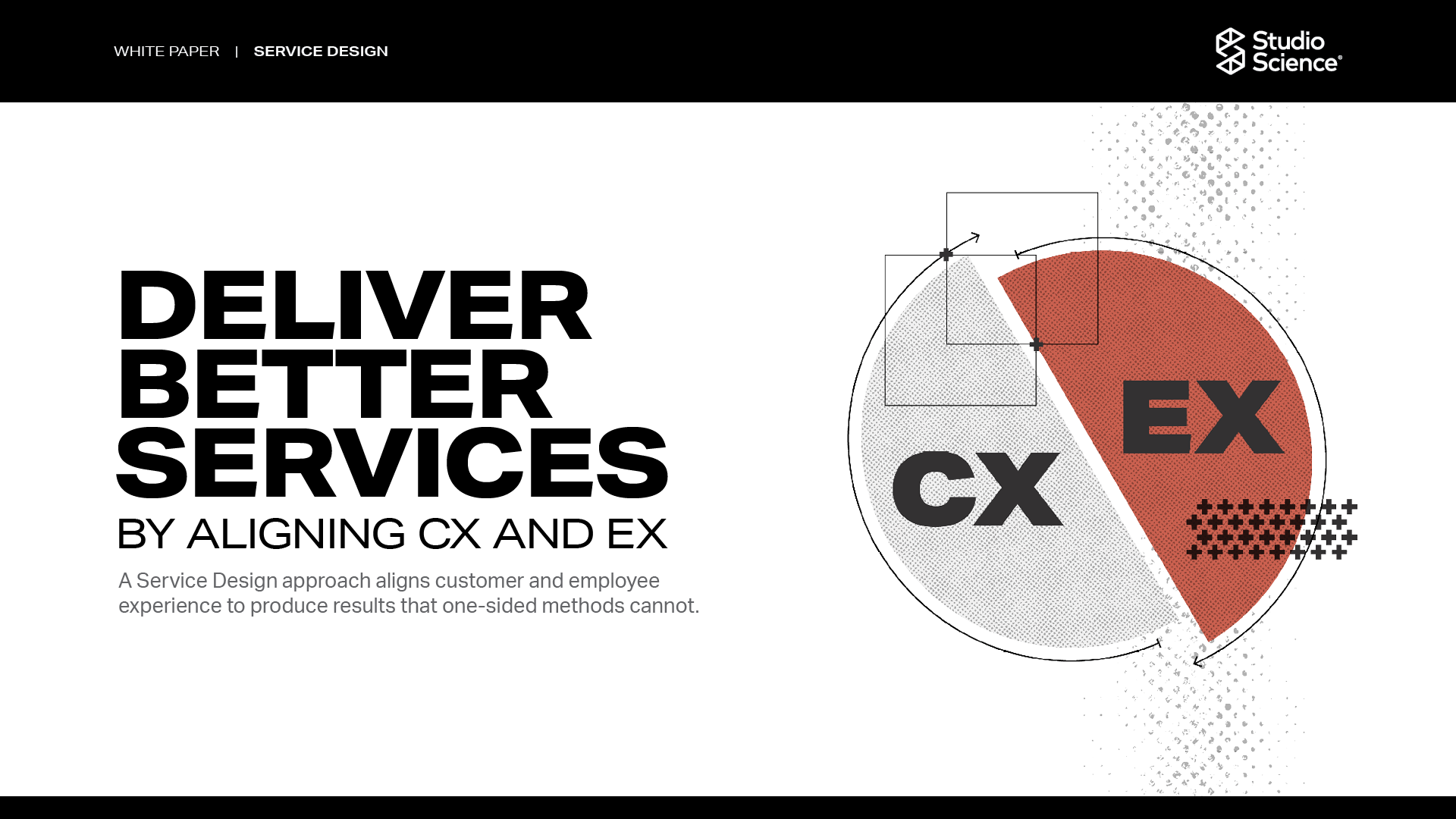

A Service Design approach aligns customer and employee experience to produce results that one-sided methods cannot.
Download white paperDeliver Better Services by Aligning CX and EX is intended for leaders within market-leading companies across all industries who have a high level of organizational maturity and place a high value on their brand reputation. It’s for those that understand the need to create better experiences for their customers and employees. It’s for leaders who are looking to yield the best results by driving both customer and employee loyalty.
Misalignment between CX and EX hinders both sides of the experience. Initiatives that attempt to improve one without considering the other are bound to fail. The only way to meaningfully address either one is to design the entire service.
Nearly 30 years ago, the concept of the Service-Profit Chain illustrated how customer experience (CX) and employee experience (EX) are part of the same connected system. Every interaction that a customer has along their journey with a company—from how they become aware of a new offering, to their purchase, to their ongoing use, and every touchpoint in between—is enabled by the capabilities of an organization. And the most critical part of an organization’s capabilities is
its people.
Because CX represents a person’s comprehensive experience throughout their entire relationship with an organization, it cannot be separated from the employee experience. Initiatives that attempt to improve one without considering the other are bound to fail. The only way to meaningfully address either one is to design the entire service.
High-performing organizations today recognize that:
1. CX design can produce significant business results, in both product and service-based sectors.
2. Optimizing EX is a foundational way to retain talent, especially during the Great Resignation.
However, many organizations are still trying to address CX and EX challenges separately.
In principle, most leaders agree that CX and EX are dependent on each other: 55% of executives in a recent Harvard Business Review Analytic Services survey said they believe it is impossible to provide excellent CX without providing excellent EX. But in practice, their approach to improving the customer experience is often one-sided—usually due to established organizational silos or not being aware of a more holistic approach.
One-sided approaches cause a misalignment between CX and EX, hindering both sides of the experience. The result is higher customer churn, expensive employee turnover, and a damaged brand reputation.
Contrary to one-sided approaches, a service design approach recognizes that CX and EX are two parts of one cohesive system we design for.
A service design approach creates improvements for customers and employees and maps the effects of these improvements on the rest of the system. To map customer and employee actions within a system, service designers use a tool called a service blueprint.
Centered around the customer journey, a service blueprint defines how an organization’s capabilities (people, policies, processes, and systems) enable the customer’s experience. With this holistic perspective on the entire service, it’s easier to see where there is tension between the customer experience and the organization’s capabilities. Recognizing these tensions and the misalignment they cause is the first step in aligning the organization.
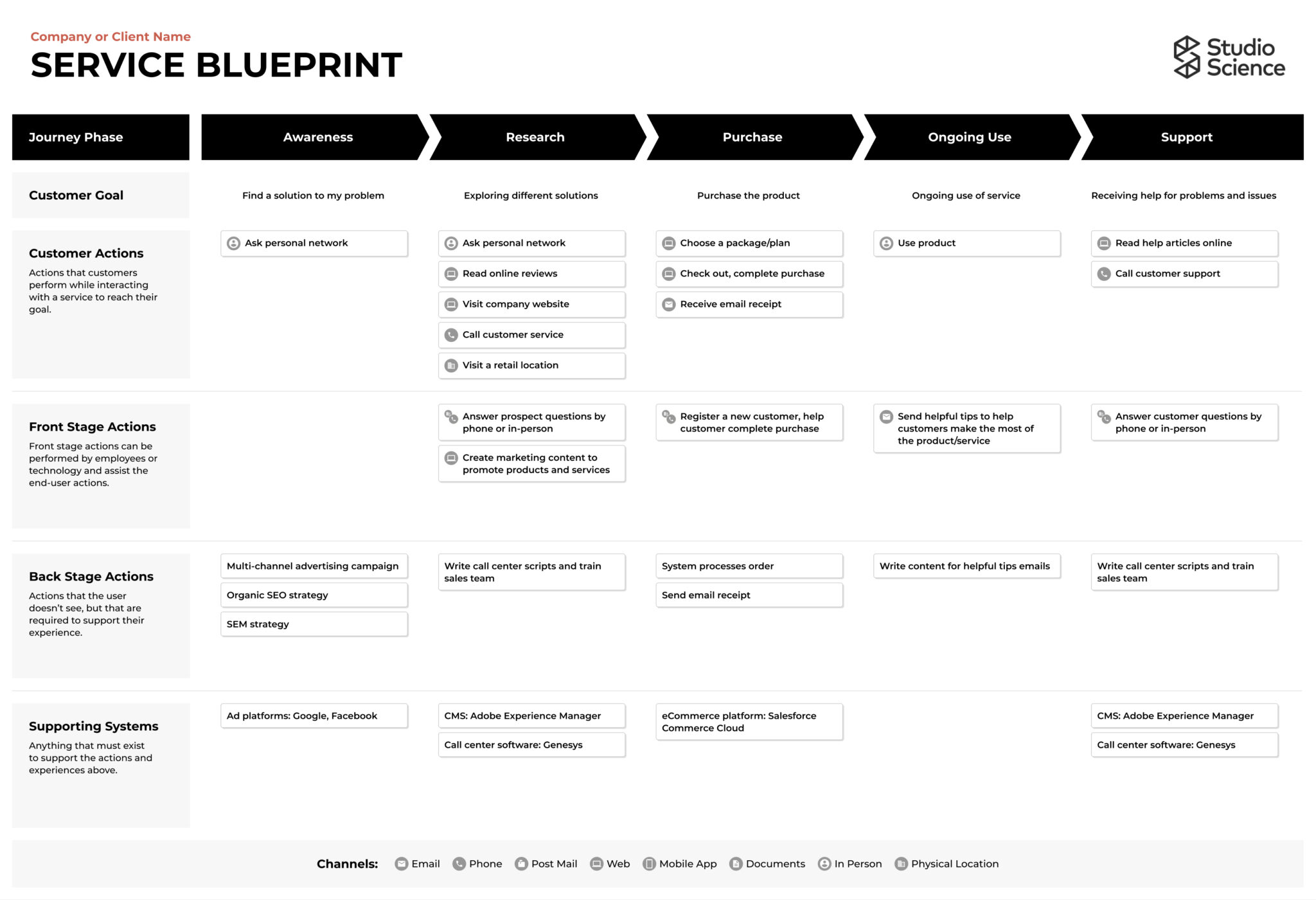
A service blueprint is an excellent tool for designing a service in its entirety.
View service blueprint templateIt’s all too common for customers to spend hours on the phone with an organization’s support team, being passed from one department to another trying to resolve an issue with a product or service, often with a low chance of success. It’s a frustrating, disconnected customer experience.
While customers might not explicitly voice concern about misalignment between CX and EX, or even recognize it as the source of their dissatisfaction, they will feel the effects of that misalignment:
“Seventy-six percent of customers expect consistent interactions across departments, but 53% say it generally feels like sales, service, and marketing don’t share information.”
– Salesforce’s “ State of the Connected Customer” report, Oct 2020
Silos between departments often develop organically due to organizational structures. But customers don’t care about organizational structures or silos. They care about the value they’re receiving. To customers, it’s all one service and one experience. When an organization or a service is misaligned—whether it’s misalignment between departments or between CX and EX at a foundational level—the customer experience suffers.
Companies cannot afford to deliver inconsistent, lackluster experiences to their customers. The customer experiences that organizations compete with are evolving faster than ever, and companies that fail to keep pace will see increased customer churn.
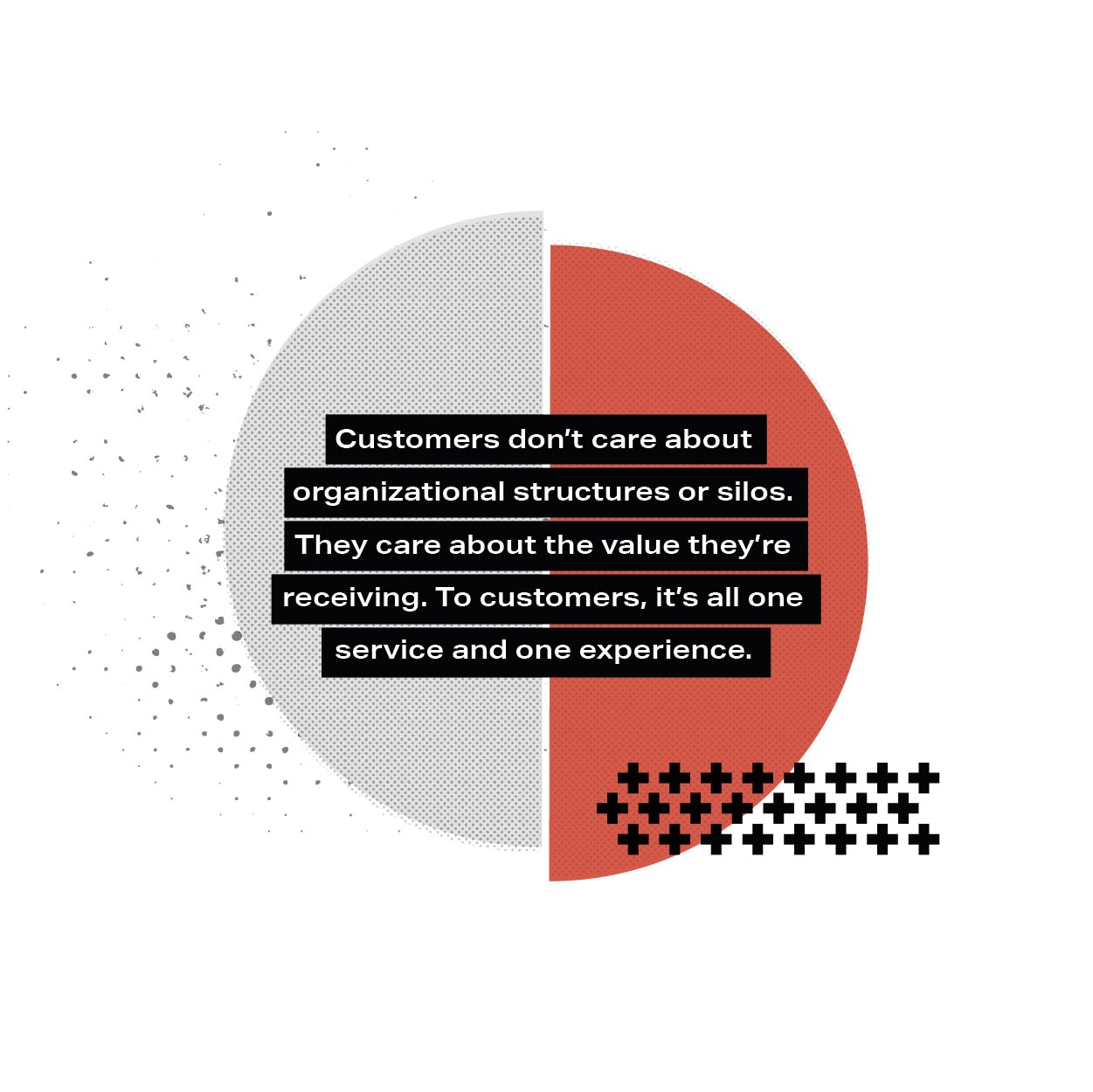

The cost of hiring–and losing–employees has never been higher, with a variety of factors coming into play. For starters, the average cost of hiring an employee is around $4,000, though this cost varies based on location, position, and industry. The cost of employee turnover is usually greater and can range anywhere between one-half to two times the employee’s salary, which takes into account lost productivity, hiring costs, training, onboarding costs, and more. On top of that, supply and demand have now made things even more challenging. According to the latest data from the US Department of Labor, labor force participation is lower today than any time in the past 20 years, with 4.2 million fewer workers in the labor force compared to just before the pandemic.
Suffice to say, companies that compromise their employee experience will not only see increased employee turnover, but higher costs to acquire new talent.
“Fifty-two percent of voluntarily exiting employees say their manager or organization could have done something to prevent them from leaving their job.”
– Shane McFeely and Ben Wigert, This Fixable Problem Costs U.S. Businesses $1 Trillion, Gallup
The employee experience extends well beyond whether or not kombucha is offered on tap in the office. When businesses notice low employee satisfaction scores or when employee turnover increases, they tend to look at one-sided solutions: provide better training, improve the hiring process, and start employee engagement initiatives. These can all be valuable, of course. But if the root of your employee experience problem is a misaligned service blueprint then these one-sided solutions will fail to provide meaningful results and only act as a bandaid to a much bigger wound.
In these situations, employees strive to meet extraordinary customer expectations without the process and system required for success. No matter how hard they work, they can’t overcome flaws in the system. They are set up to fail, which has ripple effects. Employees burn out because they are held to the unrealistic expectations of a poorly designed service. Remaining employees then take on the burden of additional work while replacements are found, which further perpetuates burnout. To achieve high customer satisfaction and lower employee turnover, organizations must redesign—and realign—the service.
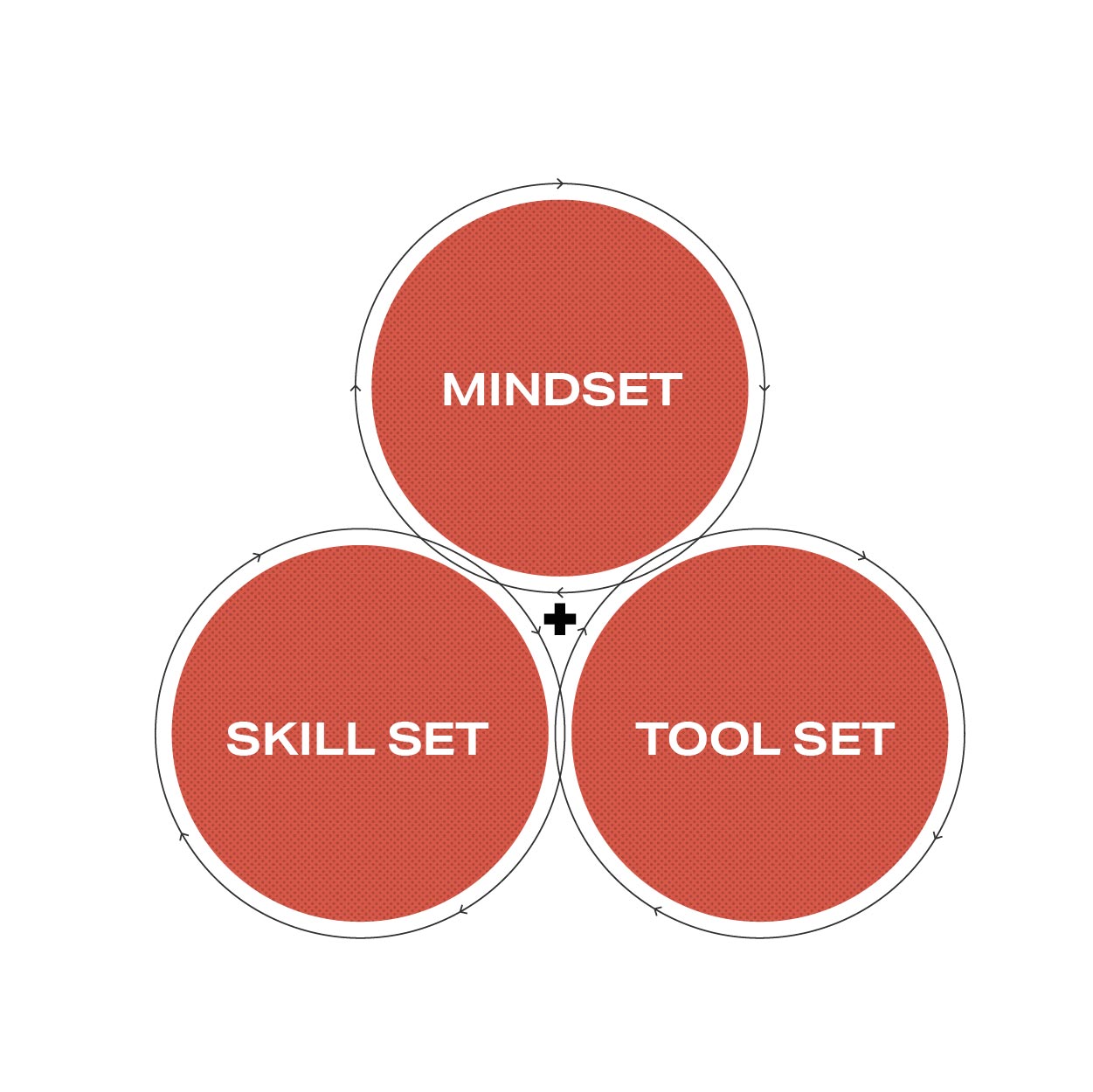
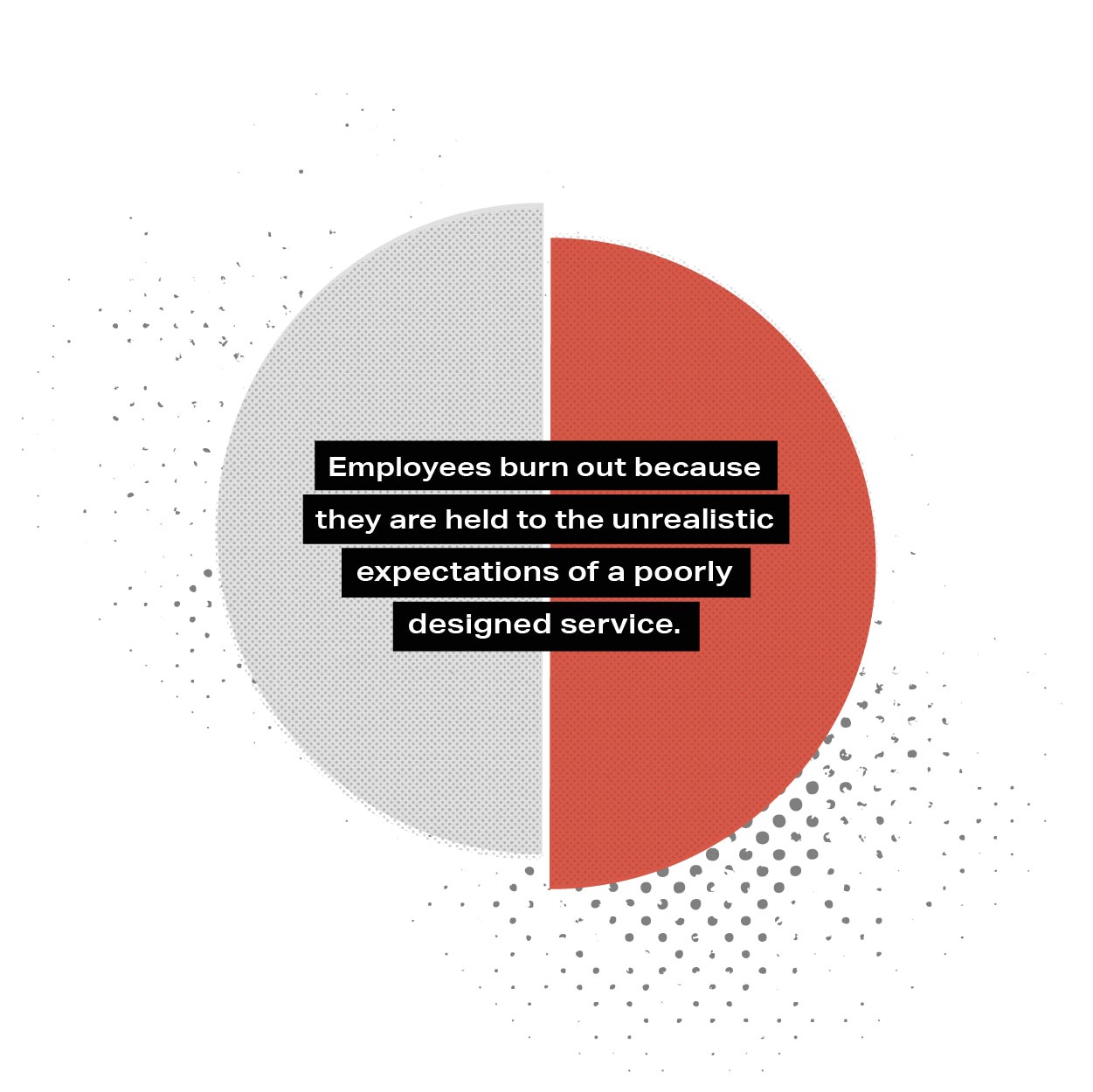
One-sided solutions can lead to failed implementations, failed customer experiences, and failure to support internal teams who must shoulder the burden of a poorly planned solution.
Organizations often try to improve customer experience by designing touchpoints across the end-to-end journey that they believe will better serve their customers’ needs. However, these initiatives are usually one-sided and fail to account for the complete system supporting the customer experience.
In service design, we refer to the supporting system as the “backstage” of the service: the people, processes, and technologies required to enable the customer experience.
If the backstage supporting the customer experience is not considered as part of the design, organizations run the risk of:
1. Failing to implement the intended customer experience due to organizational roadblocks
When an organization designs a customer experience with assumptions about capabilities, it adds risk to implementation. An organization might design a touchpoint that requires customer data from the CRM without realizing it’s a legacy system that makes integration very difficult. An initiative to improve delivery times might depend on additional work from warehouse employees already operating at maximum capacity. Mapping out the frontstage and backstage of the service helps to identify and account for capabilities before they become blockers.
2. Failing to deliver the intended customer experience once implemented
Being blocked in implementation is frustrating, but implementing a service that fails to deliver the value that customers expect can lead to even worse outcomes for the organization: high customer churn, low customer adoption, and a damaged brand reputation. Designing the service holistically—and with the relevant customer and employee stakeholders—helps ensure that an organization can realistically deliver the service.
3. Failing to support internal teams who must shoulder the burden of a poorly planned solution
When an organization designs a customer experience without considering the impact on the employees responsible for enabling and delivering the experience, employees get burned out because they’re trying to achieve goals that the design of the service makes impossible. Employees feel undervalued and resentful when leadership is out of touch with the reality of their jobs. No amount of training, employee engagement initiatives, or fancy perks can address the root problem of unrealistic demands. Redesigning the service results in higher customer satisfaction and lower employee turnover.
The best way to align CX and EX is to holistically design the service. A service design approach brings focus to the customer’s expectations and the human and technical capabilities needed to make the intended experience possible.
The best way to align CX and EX is to holistically design the service using meaningful research on the interaction between the workers and the systems that enable the customer experience.
“In order to optimize the performance of the entire system, people need to shift from trying to optimize their part of the system to improving relationships among its constituent parts.”
– David Stroh, Systems Thinking for Social Change
A service design approach brings focus to the customer’s expectations and the human and technical capabilities needed to make the intended experience possible. This yields tangible results for organizations.
1. Lower cost to serve customers
A service design approach often highlights opportunities to cut waste from the delivery of the service and focus resources on the moments that are most impactful to the customer experience. A recent ESI ThoughtLab study found that 34% of leading companies see reduced capital costs as a benefit of addressing CX and EX holistically.
2. Improved cooperation between departments
Mapping a clear view of the backstage of a service helps people in different departments across an organization see what they need to deliver to support the customer experience. This improved understanding and alignment improves cooperation between departments.
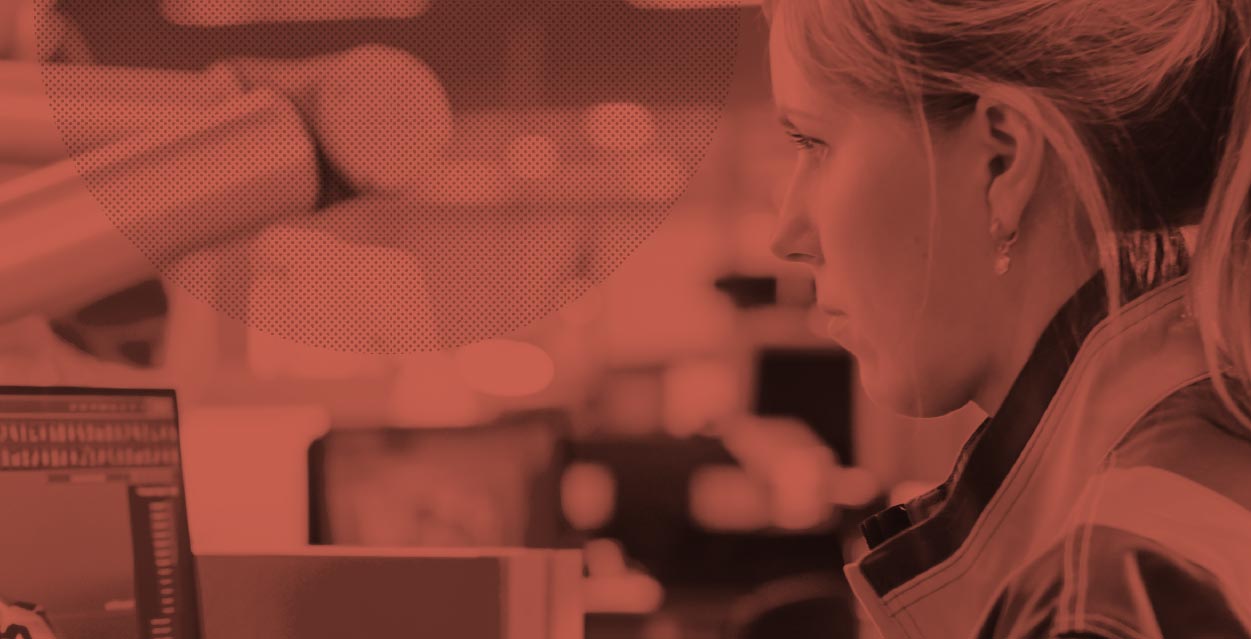
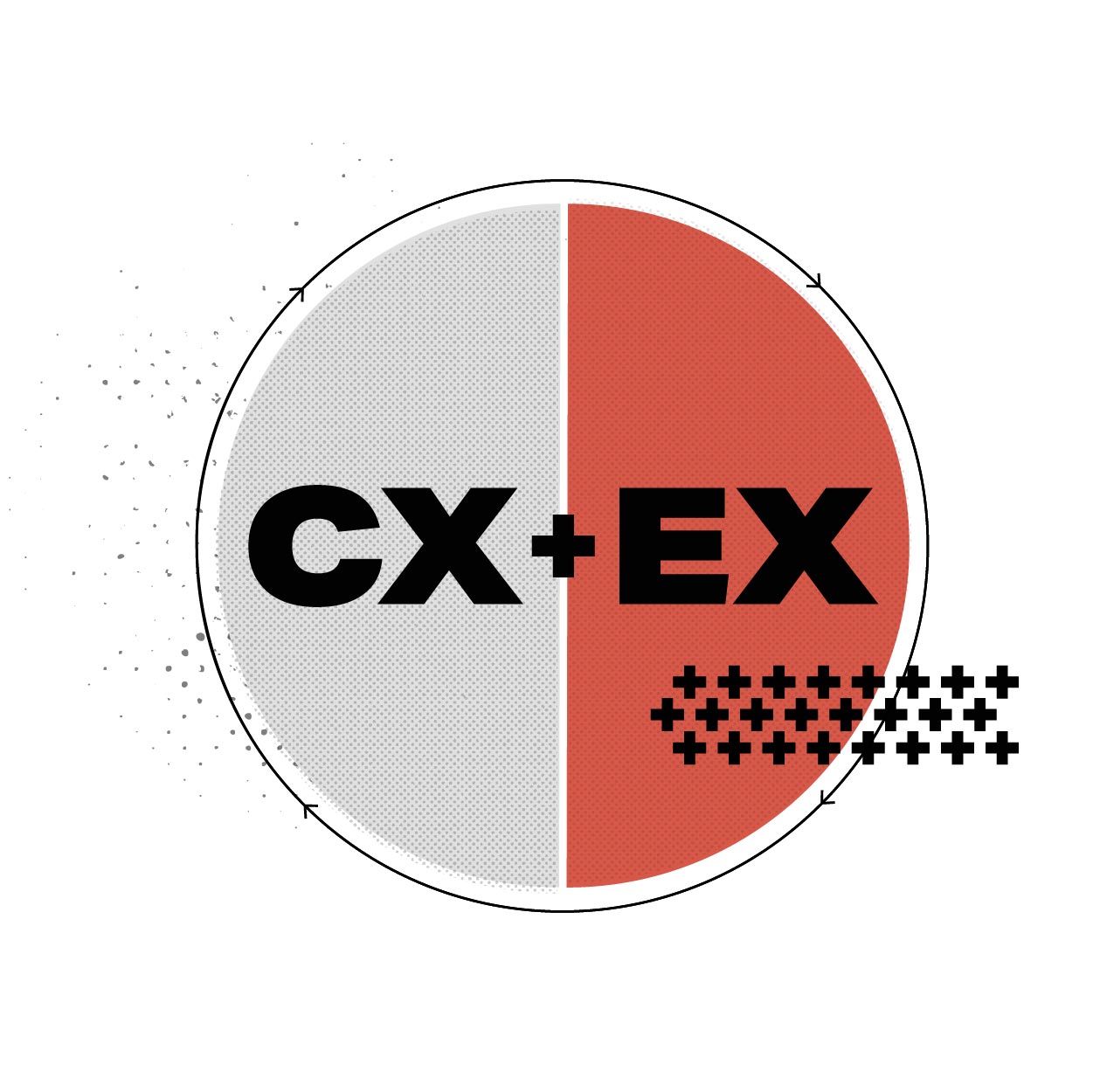
Improved cooperation between departments in a Fortune 500 Manufacturing Company
A Fortune 500 manufacturing company came to Studio Science to help with a customer adoption problem. They had built a robust digital product to help employees follow their proprietary maintenance process, but people weren’t using it. By mapping the service blueprint along the customer journey, we identified where the design of the service was misaligned with the reality of the employee experience.
Additionally, throughout the process, we found ways to bring together disparate departments trying to tackle the same problem through different one-sided solutions. Re-aligning the departments around one common goal and one holistic approach saved the organization months of time and effort.
3. Increase customer adoption and retention
Service design centers an organization around the customer journey. When an organization aligns to serve the customer on their journey, it has a profound effect on the customer experience. And improving customer experience has a measurable impact on revenue.
4. Increase employee retention
Organizations that thoughtfully align their CX and EX see lower employee burnout and turnover, saving significant costs in retaining talent. Mapping the current state of the service helps identify points of tension between customers and employees—and provides a path to solutions.

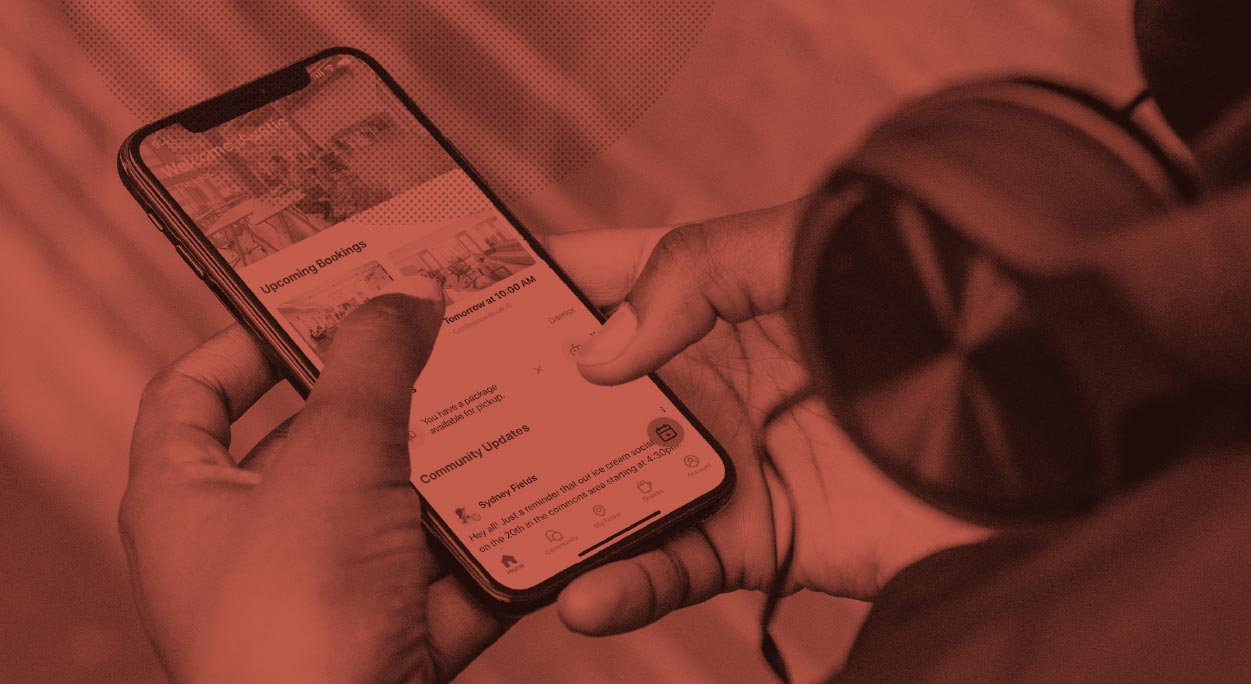
Increased customer adoption and retention by a nationwide coworking space provider
Expansive, a nationwide coworking space provider, sought to distinguish its offering in a crowded marketplace by providing world-class amenities as well as the means to access services effortlessly.
Expansive challenged Studio Science to improve the services available to coworking tenants and their guests. Studio Science designed a customer experience platform to replace its labor-intensive concierge model that relied almost exclusively on community managers.
Their existing system wasn’t meeting customer or employee needs, as evidenced by a low customer adoption rate. We started by understanding the needs of the customers (coworking members) and the employees (community managers) to design a service that would improve CX and EX. After launch, we collected and acted on feedback from customers and employees to ensure it had the intended impact on CX and EX. After its launch, the new platform eased the time burden of employees to serve customers—and the customer adoption rate rose by 70%.
Organizations must co-design the service with key stakeholders to align CX and EX meaningfully. Key stakeholders include the typical decision-makers and those that will ultimately be affected by the decisions: front-line workers and customers. They can also include providers (and their investors) who gain economic value from operating the service, communities in which the service takes place, and communities in which essential resources are produced.
Organizations that make decisions about solutions on behalf of customers create misalignment between the organization and its customers—and ultimately results in poor customer adoption and retention. Similarly, making decisions for what will work best for employees without employee involvement leads to organizational misalignment—and finally, low employee engagement and higher turnover.
At Studio Science, we utilize a transferable, repeatable methodology focused on creating as much value as possible for all stakeholders in the system. To design better experiences, we seek opportunities for innovation, we determine appropriate solutions, and we implement them effectively. We do this by co-designing with our clients’ customers and employees, which helps eliminate assumptions and ensure a successful implementation. When a service is co-designed with its customers, it is significantly more likely to meet customer needs. When a service is co-designed with the employees that will ultimately deliver that experience, it de-risks successful implementation. It gives employees more ownership of the process.
1. MINDSET
This includes empathy for the needs of all the stakeholders and appreciation that managing change requires alignment and continual realignment.
2. TOOL SET
We bring a range of special tool sets to the table that vary based on the work at hand. These include tools for conducting research, developing strategies, prototyping solutions, testing systems, and assessing and optimizing operational performance.
3. SKILL SET
This includes the facilitation of divergent and convergent thinking styles and the ability to separate content from processes.
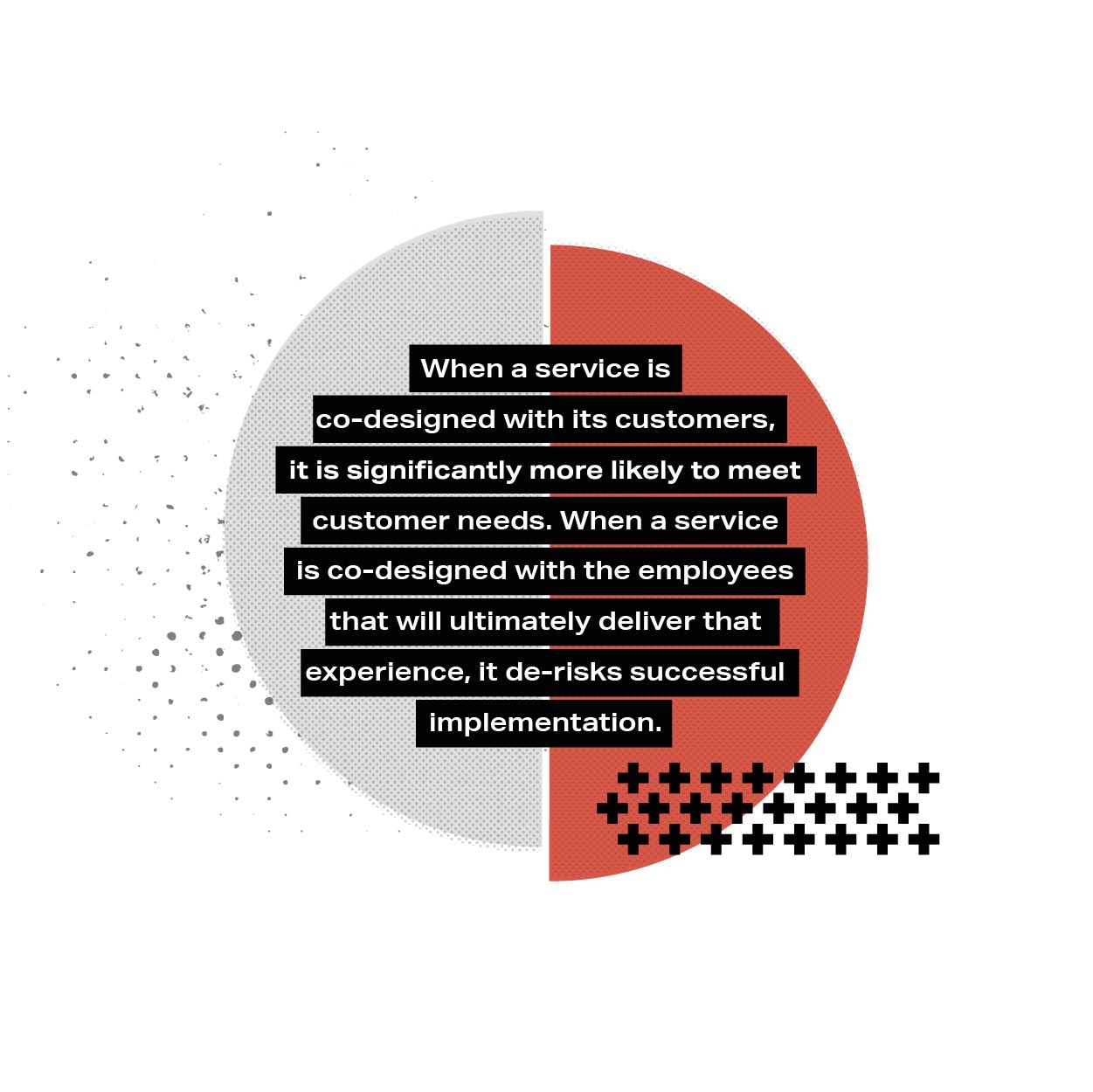


With a service design approach, organizations can align CX and EX to yield greater results than addressing either one separately. Silos break down, and departments cooperate to achieve what they could never have accomplished on their own. Customers enjoy a better experience, driving loyalty and retention. Employees thrive in an environment where the service has been intentionally designed with their needs and reality in mind.
By designing the service holistically and aligning CX and EX, organizations improve cooperation between departments, reduce cost, boost customer retention, and lower employee turnover.
Justin Zalewski, Director of Product Strategy & Design, Studio Science
Justin Zalewski is an experienced design leader who has spent the past 10+ years helping companies improve experiences for their customers and employees. He has led projects with clients ranging from market-leading technology companies to Fortune 500 brands, including Angi, Stack Overflow, Simon, and Cummins.
Justin is driven by the foundational belief that people-centered design is a powerful way to solve problems for businesses and improve people’s lives.
Justin has a passion for community and mentorship, and organizes the Indianapolis chapter of the Interaction Design Association (IxDA)—a global professional network dedicated to the practice of designing interactive digital products, environments, systems, and services. In addition to growing a team of talented designers, he shares his experiences through writing and speaking engagements with a variety of professional and educational audiences.